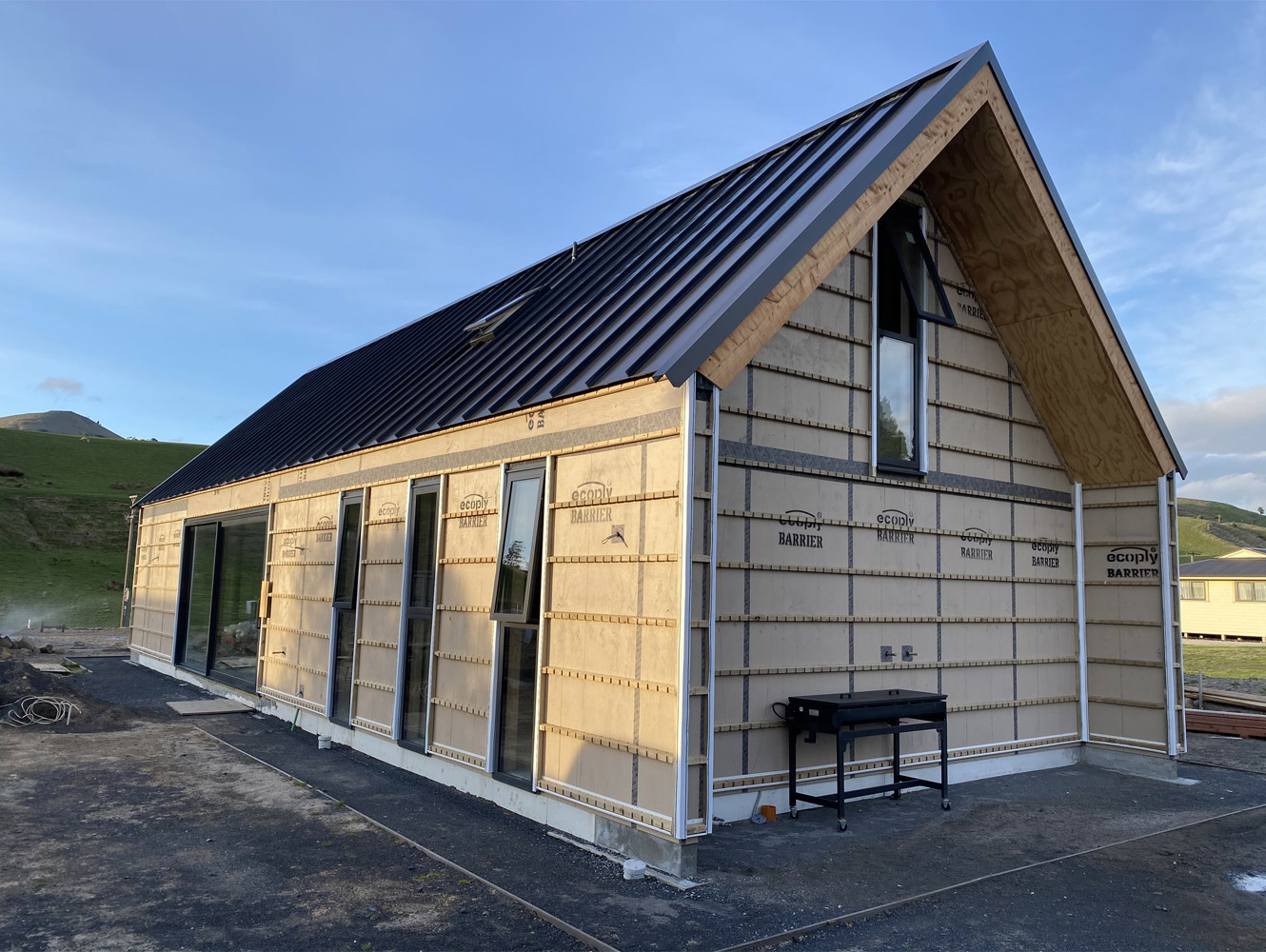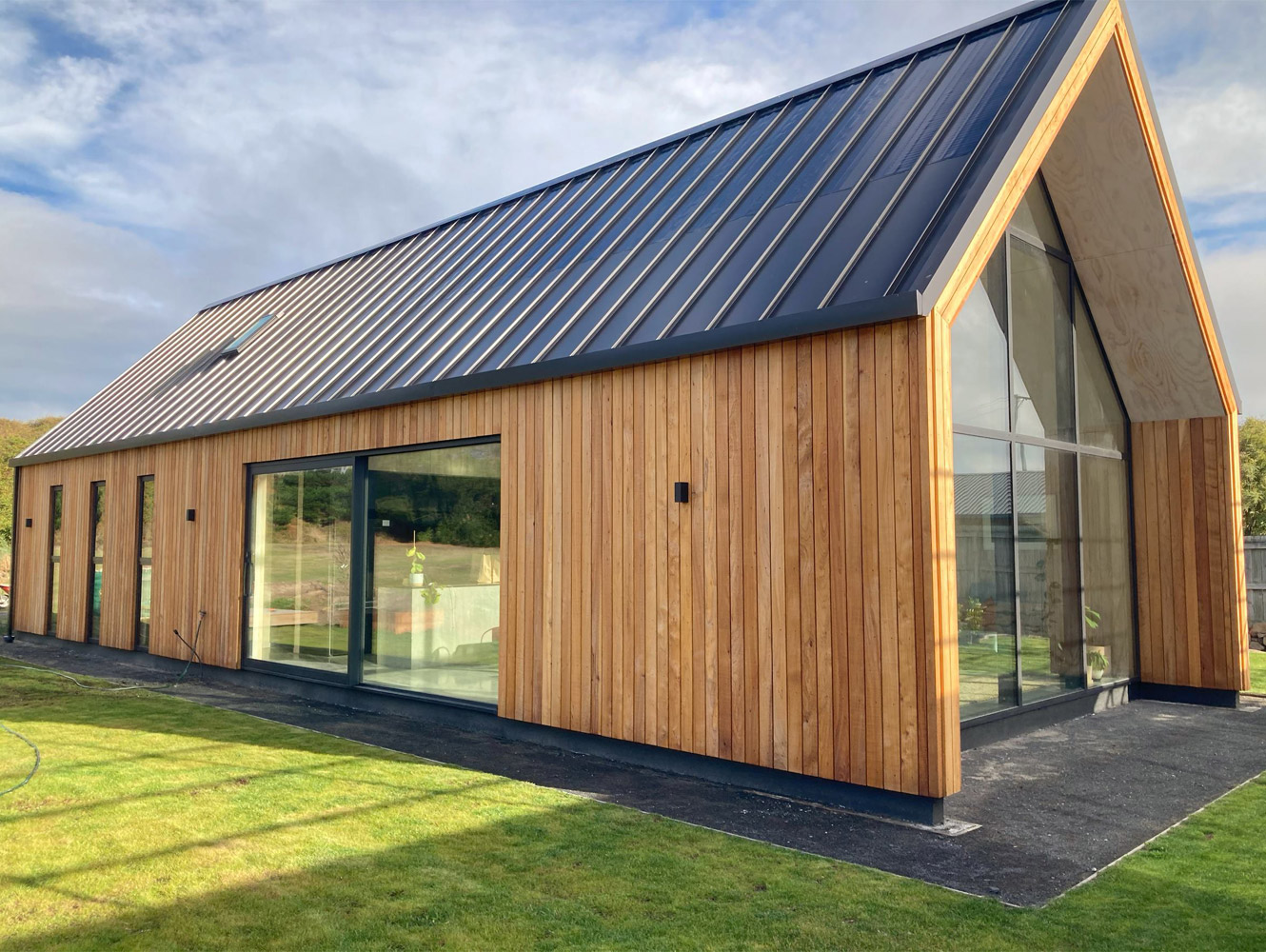
I believe that investing in smarter design, cost efficient management, and high quality building materials that are both affordable and sustainable, can provide people with a healthy home with greater longevity that will cost less over its lifecycle than a traditional home built to the minimum NZBC standard. This case study aims to provide a guide for a healthy home that is fit for purpose, affordable and sustainable to design, economic and energy efficient.
- Gary Todd


This project is the successful collaboration of the owner who is an experienced carpenter and his father an experienced architect who sought to use the core values of affordable sustainability to create a healthy home together as an exemplar model.
The original design inspiration was from the recent ‘tiny house movement’, and over time has developed to become a 100 sqm footprint with 40 sqm upper mezzanine to offer flexibility for future use by the current and any future owners.
The focus has always been on a small house and after further eco green research the scope of the project was developed to embrace a ‘quality over quantity’ approach in comparison to the trend of larger homes that have continued to increase in size but not necessarily in quality.
This healthy home is for a young couple that can host guests or family as future demands may require.
The outcome of this project has led me to believe that “better healthy homes can cost less over their life cycle compared to those that are designed and constructed often to only meet the minimum NZBC standards”.
This higher standard of healthy home is also expected to accrue at a greater rate of valve in the future compared to the traditional standard home which will fall behind in value and resale as an outdated housing model.
The use of locally sourced sustainable materials and higher quality building systems on this project illustrate that people can be proactive in creating affordable healthy homes. This type of action could also assist with providing positive solutions to address climate change. New Zealand building quality is widely known to be well below the standard of most other countries, so it is time that we apply knowledge gained from higher performance healthy homes to raise our standards.
This case study goes a long way to dispelling the myth that superior healthy homes are unaffordable as they were until recently perceived to be too expensive for the public to afford. I feel this case study illustrates that we can all become more aware, educated, and empowered to collectively design and construct healthier homes and reduce our environmental impact.
The house design includes compaction of essential services into a central core within a small footprint whilst overcoming the flaws of limited functionality common with a tiny house. The small footprint has also allowed a build of a higher specification than the NZBC minimum and has incorporated as many passive house or super home features as can be justified within a restricted budget of $420,000 including GST for an entry level home.
The house is complete with interior fit out ready for landscaping by the owner excluding professional and local authority fees for comparison with other standard housing financial models. The owner in this case study has provided the carpentry section so for true comparison to normal building rates a labour allowance of $90,000 is added to the actual building costs known to complete this case study house.
The build costs for the 140 sqm house including building labour allowance is estimated to be just under $3000 per square metre including GST.
The site is a small level section that is well drained and provides good access for delivery and storage of goods. An outdoor living area is designed including vegetable gardens and fruit trees adjacent to the kitchen for indoor to outdoor flow.
The ease of connecting to existing supply services of drainage, power and water, is preferred, opposed to going off the grid and increasing costs.
A simple rectangular gable provides a minimal external cladding area to reduce cost. It also creates a sense of spaciousness inside that flows to connect with a snug mezzanine upper floor level.
The open plan kitchen, dining and living space is orientated North to capture the main view and maximum solar gain. A roof overhang reduces summer heat gain but allows winter sun penetration to the house interior. Two bedrooms with fitted wardrobes on the lower level are to the East and West for either morning or afternoon sun with private views.
A bathroom with a toilet, stairs to the mezzanine and a separate laundry are accessed by short hallways either side of the kitchen. The upper level mezzanine within the sloping roof space is a more affordable option than increasing site coverage and has the ability to become a third bedroom simply by adding an internal wall in the future if desired.
Standard sheet sizes have been used to ensure that material waste is minimised. The repetitive aluminium joinery and glazing design has reduced manufacturing costs by utilising standard supply material sizes. Natural cross ventilation of spaces is achieved by locating opening windows or doors on opposite walls.


The North facing site has an insulated Maxraft concrete floor slab creating desirable thermal mass which reduces heating and cooling costs and provides the maximum use of the interior footprint up the glazing face for human thermal comfort level. The polished slab is a cost-effective finish instead of carpet which also avoids health issues of dust mites or asthma. The thermal mass of concrete is utilised to capture and store the solar gain by day and release heat again at night to maintain a stable temperature of the interior.
The exterior wall timber framing is 140mm thick with the increased depth allowing for a higher level of R3.6 wool insulation than 90mm thick framing permitted by the NZBC.
We have learned that 45mm thick exterior structural cavity battens can allow wall framing dwangs to be deleted so that the wall insulation can better fit between studs continuously from bottom plate to top plate. This can lead to greater performance of the insulation and reduces installation costs.
This option for wall framing and insulation, and location of the steel work to avoid thermal bridging on the exterior wall is intended to be used in the next project.
The purpose of these options is to illustrate that continued sharing of information with others results in better construction and performance. The use of eco ply sheets with taped joints to seal the building perimeter has allowed work to continue inside even in bad weather.
Triple glazed, thermally broken window and door joinery reduces thermal bridging and avoids condensation issues.
Higher levels of thermal performance are provided through R4 wool ceiling insulation. All wall and ceiling insulation is covered with Intello wrap installed by the owner to create an airtight environment inside the house.
A balanced mechanical heat recovery system controls ventilation and air filtering of the interior environment. The MHRV draws fresh air from the exterior through a preheating filter to disperse purified air to the living space and bedrooms. The extracted air from the bathroom and laundry preheats the filtered air entering the house. This system controls temperature, humidity and moisture which provides a healthy living environment well above NZBC requirements. The purchase of MHRV parts only and installation completed by the owner, has reduced subcontractor costs.
The key features of superior insulation, air tightness and mechanical ventilation provide and maintain an interior environment that is warmer, quieter and healthier than standard traditional homes that are designed and built only to meet the NZBC minimum standard.
The house will be clad in locally sourced macrocarpa from a sawmill rather than a building supply merchant which reduces costs. The heart macrocarpa is similar in appearance to the more common imported cedar, however costs half the price with a much better carbon footprint by reduced transportation cost and reduced C02 emissions. The macrocarpa timber has a linseed oil finish which will be left to weather to a natural silver colour.
The use of plywood as a durable stable cost-effective lining has eliminated the need for alternative gib lining and stopping where two coats of white-wash on plywood was used in lieu of the standard three coat system of painting for other linings.
The reuse of plywood offcuts for joinery shelving is an example of a minimal waste approach for the project. All waste off cuts are stored for fire wood rather than sent to landfill. The wood fire is the only heating source required for the house, with in-slab heating pipes installed for a future option of additional heating should this be required. To reduce power costs, PV laminate solar panels are adhered to the Colorsteel tray roofing. These panels are estimated to produce approximately 8000kWh of electricity a year which is equivalent to the standard residential home.
